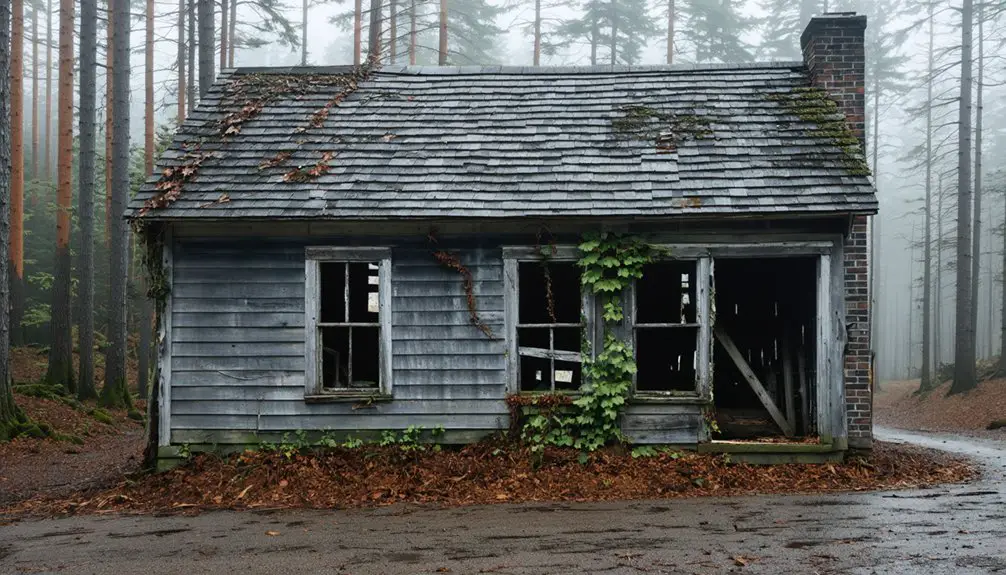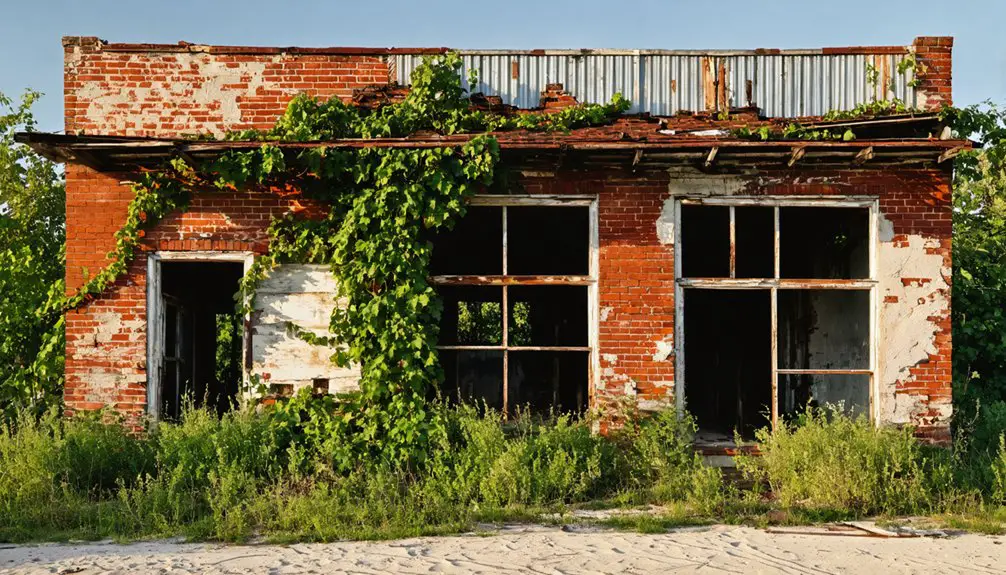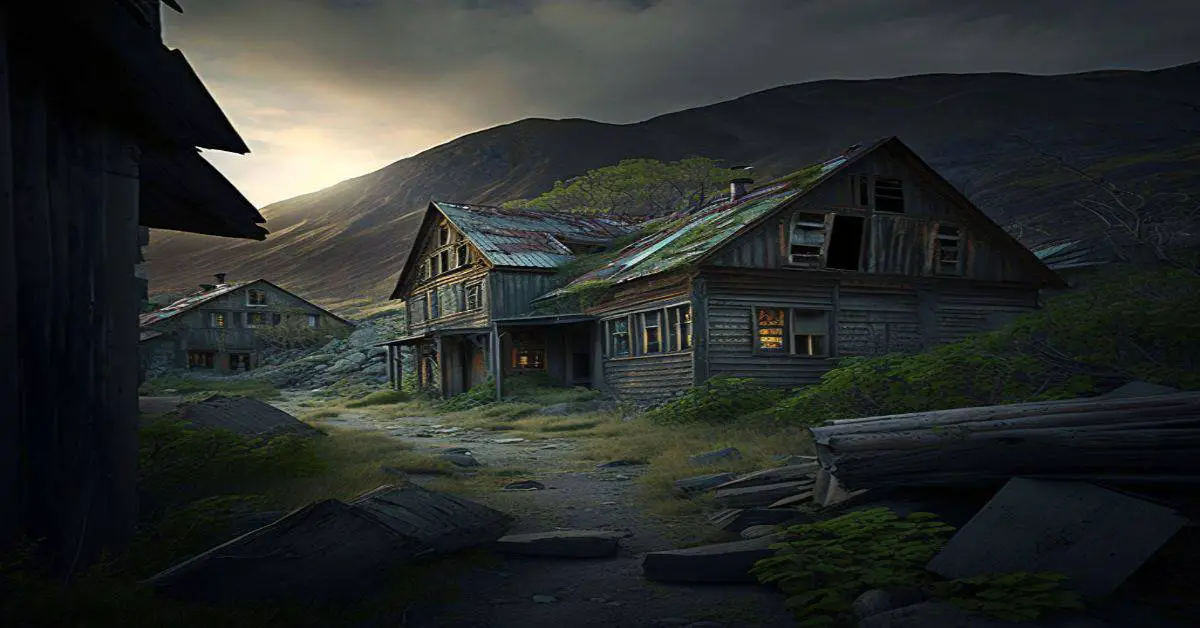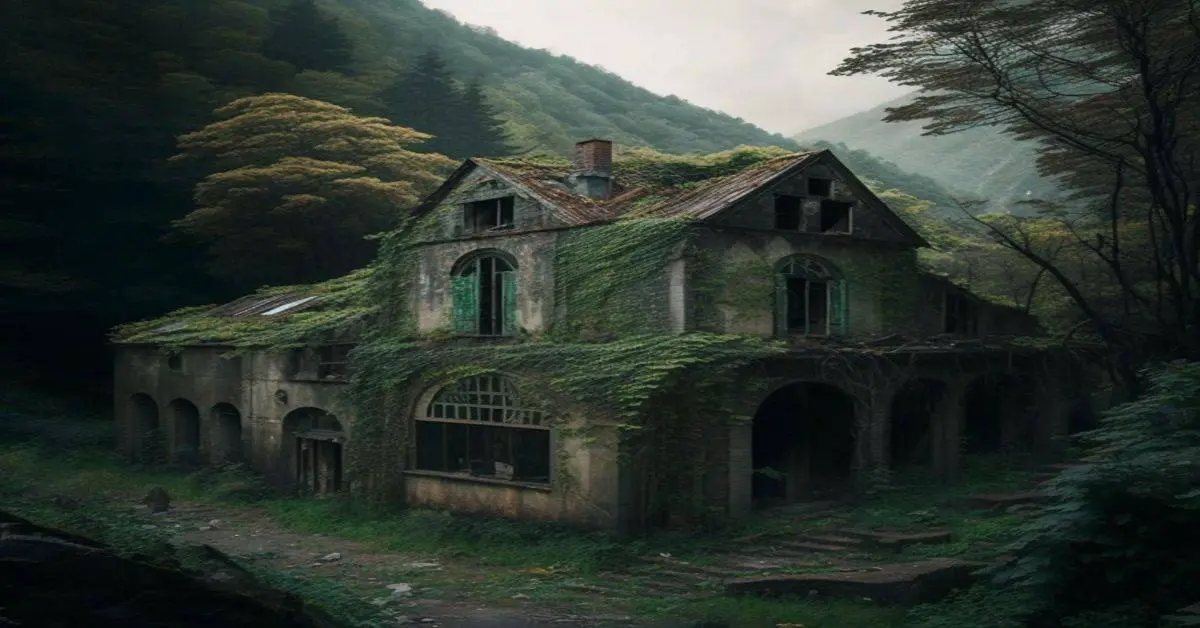You’ll find Crofton among Michigan’s most significant copper mining ghost towns, established in 1844 when the Cliff Mine sparked the region’s mining boom. The town quickly grew to 700 residents as miners extracted high-grade copper using innovative techniques, descending 1,000 feet into dangerous shafts. While the bustling community once thrived with ethnic clubs and mutual aid societies, today’s quiet ruins tell a compelling story of America’s industrial transformation.
Key Takeaways
- Crofton transformed from a prosperous copper mining settlement to a ghost town following the decline of the Cliff Mine operations.
- The town’s peak population reached 700 residents by 1877 before declining as mining opportunities dwindled.
- Abandoned wooden homes, shuttered businesses, and deteriorating infrastructure mark the town’s transition to ghost town status.
- The community’s collapse followed the typical boom-and-bust pattern common to 19th-century mining settlements in Michigan.
- Former residents occasionally held reunions, highlighting the abandoned town’s historical significance in Michigan’s copper mining industry.
The Birth of a Mining Town
When Cliff Mine opened its doors in 1844, it marked the beginning of Michigan’s copper mining industry and gave birth to the bustling town of Crofton.
Under the leadership of Pittsburgh pharmacist John Hays, the mine pioneered unique mining techniques, driving horizontal tunnels at the cliff’s base to extract solid copper. At its height of production, the operation yielded an impressive 38.2 million pounds of refined copper.
You’d have found the initial settlement clustered near Eagle River, where workers and their families built their lives at the cliff’s foot. The town grew rapidly and reached a population of 700 residents by 1877.
The mine’s unprecedented success drew miners from England, France, Germany, and beyond, infusing the town with rich cultural diversity.
As operations expanded, the community strategically relocated across the road to embrace the newly established Keweenaw Central Railroad station, transforming Crofton into an essential hub of America’s copper boom.
Life During the Boom Years
You’d have found Crofton’s miners enduring grueling days of hand-drilling and ore hauling, descending nearly 1,000 feet underground to work in dangerous conditions.
In your free time, you could’ve joined the vibrant immigrant community gatherings at ethnic clubs, religious institutions, or family celebrations that helped workers cope with their harsh daily reality.
The town’s social fabric wove together diverse European traditions, as British, Scandinavian, and Eastern European workers brought their customs and languages to this bustling mining settlement of 2,000 residents.
The miners extracted pure native copper directly from the rock, unlike other regions where copper was found in oxide or sulfide forms.
The region’s mines penetrated depths of over 9,000 feet, making them among the deepest copper excavation sites in America.
Daily Mining Life
Deep beneath Michigan’s surface, miners faced grueling daily routines that began with a treacherous descent down nearly 1,000-foot ladder systems into the dark mine shafts.
You’d find yourself working in teams of three, wielding mining tools like drill bits and hammers to bore holes into stubborn rock faces. With limited ventilation and only the dim glow of oil lamps to light your way, you’d carefully pack these holes with black powder for blasting. Your boots featured steel horseshoe soles for navigating the treacherous terrain underground.
The underground hazards were constant companions – flooding tunnels, unstable rock walls, and suffocating dust filled your 12-hour workday.
After each blast, you’d extract massive copper pieces and haul them to the surface. Your world was one of physical endurance, where steam engines and primitive pumps offered little relief from the backbreaking labor that defined mining life.
Social Gatherings and Entertainment
After enduring grueling shifts underground, miners in Crofton found release in a vibrant social scene centered around the town’s numerous saloons and hotels.
You’d find these establishments packed with workers drinking, gambling, and sharing stories late into the night. The town’s general stores served as daytime gathering spots where community bonds formed through casual conversation and news exchange.
Cultural celebrations brought together Crofton’s diverse immigrant population, with seasonal festivals and religious observances providing regular opportunities for socializing. The Keweenaw copper boom brought unprecedented wealth to the region, allowing miners to spend generously on entertainment.
While churches and schools offered more structured gatherings, the “work hard, play hard” attitude often led to rowdy entertainment. Music, dance, and brothels were part of the accepted nightlife, though this atmosphere of lawlessness frequently sparked brawls and violence in the chiefly male mining town. Some residents sought refuge at the Bete Grise harbor during violent storms that swept through the region.
Mining Operations and Economic Growth
While Michigan’s Upper Peninsula was still largely untamed wilderness in the 1830s, the discovery of rich mineral deposits transformed Crofton and its surrounding region into a bustling mining district. The Jackson Mining Company established the first commercial iron mine in 1845, marking the beginning of large-scale operations.
Mining technology evolved rapidly from basic hand tools to steam-powered equipment, with innovations like the 45-ton steam engine at Cliff Mine revolutionizing ore extraction and processing. The high-quality ore contained 65 to 80 percent iron content and was easily quarried from stratified layers. The economic impacts rippled throughout the region, establishing Michigan as a world-leading copper producer.
Michigan’s rapid adoption of steam-powered mining equipment transformed it into a global copper powerhouse in the 1800s.
- Miners would descend deep shafts on long ladders, working in small teams to drill holes and blast through rock using black powder.
- Steam-powered mills processed hundreds of tons of ore each season, while railroads and docks transported materials.
- The industry attracted skilled immigrants from Finland, Sweden, Italy, and Germany, rapidly growing mining camps into thriving communities.
Daily Life in Historic Crofton
You’d find Crofton’s working families living in modest company-owned houses, where they created homes despite the harsh conditions of Michigan’s Upper Peninsula.
After long days of physical labor, workers could unwind at the town’s saloons and pool halls, though the heart of social life centered around church gatherings and community events. The winters were especially challenging with an average of 240 inches of snow blanketing the region each year.
Downtown Crofton supported daily commerce through essential businesses like the boarding house and livery stable, serving both permanent residents and the steady stream of seasonal workers who passed through the logging town.
Mining Workers’ Social Life
Despite spending long hours underground, Crofton’s mining workers maintained vibrant social lives centered around company-sponsored halls and communal gathering spots.
You’d find miners building social camaraderie through boxing matches, card games, and weekly dances that helped relieve the stress of their demanding work schedules. These recreational traditions often blended various immigrant cultures, with fiddle music and storytelling bringing the community together.
Here’s what made socializing in Crofton unique:
- Workers organized mutual aid societies that provided both social networking and practical support.
- Local taverns and company stores served as crucial information hubs where you could catch up on community news.
- Ethnic clubs preserved cultural heritage through festivals and traditional celebrations while fostering unity among diverse groups.
Family Housing Conditions
Living conditions in Crofton’s mining community reflected the harsh economic realities of the era, with families squeezed into hastily constructed wooden homes that often lacked basic amenities like running water and indoor plumbing.
You’d find housing overcrowding as the norm, with multiple generations sharing cramped one or two-room dwellings built from locally sourced lumber and mining byproducts. Extended families and boarders would pack these modest structures, maximizing shared resources to survive the boom-and-bust cycles of mining life.
Daily routines centered around basic needs – fetching water from wells, maintaining outdoor privies, and tending to kitchen gardens when possible.
Despite the challenging conditions, neighbors formed tight-knit support networks, helping each other with childcare, home repairs, and sharing essential resources during difficult times.
Downtown Commerce Activities
Through the bustling streets of historic Crofton, daily commerce centered around essential establishments that served both locals and travelers alike. The town’s commercial hubs included a general store, post office, and fish market, creating dynamic retail dynamics that kept the community thriving.
You’d find the Ottawa House hotel welcoming visitors while traders facilitated berry exports at local warehouses.
- Local markets buzzed with activity, selling fresh blueberries, raspberries, and strawberries.
- The two-mile railroad and pier created crucial trade connections for your produce and lumber.
- Daily business transactions at the general store and post office kept you connected to the wider world.
Despite economic challenges from the 1837 crash, Crofton’s downtown commerce adapted, shifting from industrial aspirations to agricultural exports that sustained the community well into the 20th century.
The Slow Descent Into Abandonment
While Clifton’s initial prosperity seemed assured by the copper-rich Cliff mine, the town’s gradual decline began when the precious metal deposits started running dry.
You’d have witnessed clear abandonment patterns as families packed up and left, seeking opportunities elsewhere in Michigan or heading west. The town’s diverse mix of Irish, German, French Canadian, and Cornish miners scattered, leading to dramatic population shifts that hollowed out the once-vibrant community.
The remote location didn’t help – with limited transportation options and dwindling services, staying became increasingly difficult. Churches closed their doors, businesses shuttered, and infrastructure crumbled from neglect.
Though former residents would occasionally gather for reunions, these meetings only emphasized how completely the mining town’s spirit had faded into history.
What Remains Today

Fragments of Crofton’s mining heritage persist in the remote Michigan wilderness, where you’ll find scattered ruins of churches, houses, and industrial structures slowly surrendering to nature’s reclamation.
The town cemetery stands as one of the best-preserved remaining structures, offering glimpses into the lives of former residents through weathered tombstones and burial markers.
Among the ruins, only the cemetery endures, its weathered stones whispering stories of those who once called Crofton home.
- Rusted mining equipment and foundational remnants dot the landscape, telling tales of industrial ambition.
- Broken pottery and domestic artifacts reveal traces of daily life among the marshy, overgrown terrain.
- While remote and challenging to access, these ruins serve as a reflection of the temporary nature of human settlement.
The site now belongs primarily to wildlife and vegetation, with forest growth steadily consuming the physical evidence of Crofton’s existence.
Historical Significance in Michigan’s Upper Peninsula
Beyond the physical remnants scattered across Crofton’s landscape lies a deeper historical legacy that shaped Michigan’s Upper Peninsula. You can trace Crofton’s influence through its role in America’s industrialization, as the town’s copper mines supplied essential raw materials to growing national and international markets.
As part of the Upper Peninsula’s cultural heritage, Crofton exemplifies how immigrant communities forged tight-knit societies in remote locations, building schools, churches, and mutual aid organizations despite harsh conditions.
The town’s story reflects the broader environmental impact of 19th-century mining operations, while highlighting the boom-and-bust cycle that defined many mining settlements. Like its neighboring communities, Crofton’s development, peak, and eventual abandonment mirror the transformative power of resource extraction in shaping both the region’s economy and its social fabric.
Legacy of the Copper Kingdom
The ancient legacy of Michigan’s Copper Kingdom stretches back over 6,000 years, beginning with the Old Copper Culture of Indigenous peoples around 4000 BC.
Through innovative mining technology and extensive copper trade networks, this region shaped North America’s early metallurgy and commerce.
You’ll find evidence of this rich heritage in three transformative developments:
- Indigenous peoples established continent-wide trade routes, distributing Michigan copper tools and artifacts across North America.
- Early commercial mining operations introduced industrial-scale extraction methods, using stamp mills and smelters to process vast quantities of ore.
- The development of mining towns like Crofton created a booming economy that helped fuel America’s industrialization.
Today, ghost towns like Crofton stand as evidence to the boom-and-bust cycle that defined Michigan’s copper industry, preserving stories of technological innovation and economic transformation.
Frequently Asked Questions
Are There Any Paranormal or Haunted Locations Reported in Crofton?
Barking up the wrong tree if you’re searching for haunted houses or ghost sightings here. You won’t find documented paranormal activity in Crofton, as historical records don’t mention any supernatural occurrences.
What Specific Native American Tribes Inhabited the Crofton Area Before Settlement?
You’ll find the Ojibwe had the strongest influence here, with Ottawa settlements also present nearby. These Anishinaabe tribes used the area’s waterways and forests for hunting and seasonal camps.
How Accessible Is Crofton to Modern-Day Visitors and Ghost Town Explorers?
Think you’ll find amazing accessibility options? Well, you’re in for an adventure – you’ll need your own vehicle, offline maps, and good hiking boots. No visitor guidelines or facilities await.
Were There Any Major Disasters or Accidents in Crofton’s Mining History?
You won’t find records of major mining accidents or disasters specifically in Crofton’s operations, though the area’s miners faced similar hazards as other Upper Peninsula iron mines during that era.
Did Any Notable Historical Figures or Entrepreneurs Have Connections to Crofton?
While Alex Joudon’s Port Sheldon Land Company operated nearby, you won’t find many notable entrepreneurs directly connected to Crofton itself. Historical connections were mainly through regional mining and development ventures.
References
- https://witl.com/one-of-michigans-first-ghost-towns/
- https://99wfmk.com/clifton-ghost-town/
- https://www.youtube.com/watch?v=7-vjuqiGWJU
- https://www.visitkeweenaw.com/things-to-do/museums-history/ghost-towns/
- https://lostinmichigan.net/the-hard-scrabble-ghost-town-of-keno-2/
- https://www.onlyinyourstate.com/experiences/michigan/abandoned-mine-mohawk-mi
- https://www.visitkeweenaw.com/blog/post/our-top-7-keweenaw-ghost-towns-to-explore/
- https://www.youtube.com/watch?v=gzGd0dY2CW4
- https://en.wikipedia.org/wiki/Copper_mining_in_Michigan
- https://www.nps.gov/kewe/learn/historyculture/copper-mining-timeline-page-2.htm


